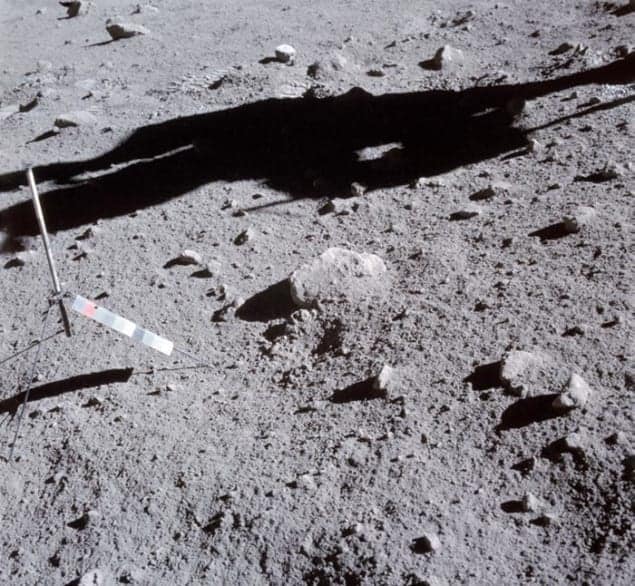
Scientists in the US claim that water on the Moon’s surface could have originated from the solar wind. Their experiments on lunar samples reveal the presence of significant amounts of hydroxyl inside glasses formed in the lunar regolith by micrometeorite impacts.
Although the possibility of water existing on the Moon has been debated since the 1970s, it was only in 2008 that the exact amount of water was confirmed thanks to technological developments. The following year NASA’s Lunar Crater Observation and Sensing satellite (LCROSS) crashed into a permanently shadowed lunar crater and ejected a plume of material that proved to be surprisingly rich in water ice. Water and other hydrogen compounds (OH, CH or H2) have also been detected in the lunar regolith – the layer of fine powder and rock fragments that coats the lunar surface.
Two years ago, LCROSS once again detected water in the lunar regolith in the form of ice, which made it clear that water exists on the Moon. But to help answer the question of how that water got there, researchers considered different ways in which the surface water could have formed on the Moon, including from the solar wind, a comet striking the lunar surface or volcanic degassing. Although lab simulations of solar-wind bombardment successfully produced hydroxyl compounds – which consist of one atom of hydrogen and one of oxygen – in lunar soils, the exact origin and storage of hydrogen in lunar soils remained unknown.
Looking at grains
In this new work, however, lead author Yang Liu of the University of Tennessee, along with colleagues of the University of Michigan and the California Institute of Technology, have measured hydroxyl in soil grains in Apollo samples. They then used the techniques of Fourier transform infrared spectroscopy and secondary-ion mass spectrometry to determine the chemical form of the hydrogen in a substance, as well as its abundance and its isotopic composition.
“With the infrared spectroscopy, conducted in the Youxue Zhang’s lab at the University Michigan, we can tell the form of ‘water’ – whether it is OH, H2O or CH,” explains Lui. With the secondary ion-mass spectrometry, conducted at Caltech, the team measured the amount of hydrogen and its chemical make-up. “We found that the ‘water’ component – the hydroxyl – in the lunar regolith is mostly from solar-wind implantation of protons, which locally combined with oxygen to form hydroxyls that moved into the interior of glasses by impact melting,” says Zhang.
Tracing the origins
The solar wind is a constant flow of charged particles from the sun and Liu says that its energy is enough to damage the surface of a grain but is low enough to be embedded and bound with oxygen on the surface. “During later impact melting of lunar soils, some of the hydrogen was transferred and stored in the glass formed by the impacts,” she says. Liu adds that without the protection of an atmosphere or a permanent magnetic field, solar wind has bombarded the surface of the Moon and other airless bodies for billions of years, delivering the necessary ingredient for making the hydroxyl.
“All previous studies of lunar samples were not able to determine the chemical form of hydrogen, but now, we have determined that the hydrogen in lunar soils exists as hydroxyl in the glass,” says Lui. Because of a combination of lab-based simulation and remote sensing, the team believes that it has robust evidence for solar-wind origin for some of the lunar surface water. For lunar polar ice, Liu’s finding suggests a possible source from solar wind in addition to comet impacts. These findings also suggest that water could exist on Mercury and on asteroids such as Vesta or Eros, further within our solar system. Although these bodies have very different environments, Lui believes that they all have the potential to produce water.
“Lunar regolith is everywhere on the lunar surface, and glasses make up about half of lunar regolith,” she says. “So our work shows that the ‘water’ component, the hydroxyl, is widespread in lunar materials, although not in the form of ice or liquid water that can easily be used in a future manned lunar base.”
$25,000 per pint
The researchers also point out that their findings show that there is a volumetrically large reservoir for water available on the Moon and that it is a valuable resource. “With the cost of $25,000 for taking one pint of water to the Moon, it is essential that we develop processes of producing water from the materials on the Moon. This is paramount to human settlement of the Moon in the near future,” says Lui.
This water would be of most value as rocket fuel – in the form of liquid hydrogen and liquid oxygen – she explains, adding that it has been suggested by others that water ice from the lunar North Pole alone could be converted to fuels equivalent to a space-shuttle launch every day for 2200 years. “Now we have ready sources of water that can be consumed by plants and humans but also dissociated into its constituent elements – O2 and H2. Thus, the Moon is a good candidate as a jump board for missions to Mars and beyond.” In the future, the researchers are keen to examine more lunar samples to come up with a good estimate of the “water budget” on the Moon.
The work was published in Nature Geoscience.



